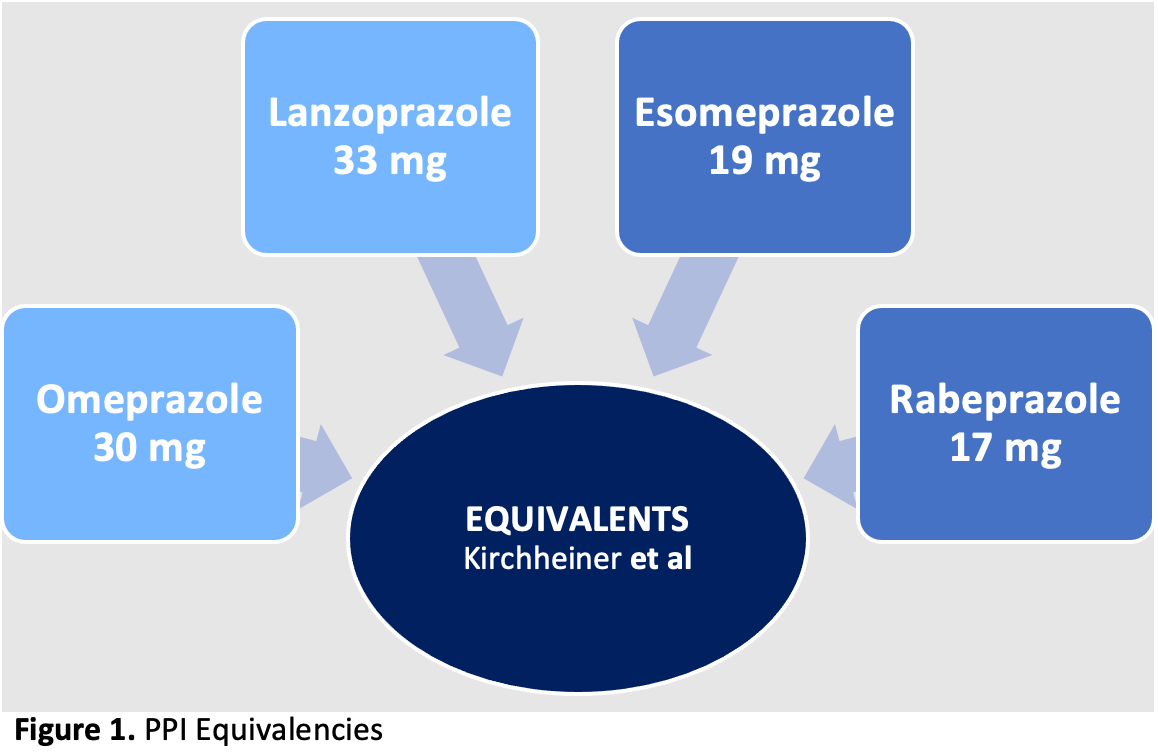Article
Don’t Worry, Be haPPI: Updates on PPI Equivalencies
Author(s):
Different guidelines have notable differences between equivalency dosing of proton pump inhibitors (PPI), resulting in confusion and a lack of confidence between medical professionals recommending one PPI over another.
Proton pump inhibitors (PPIs) are arguably one of the most prescribed medications in practice. They help control prevalent disease states, such as gastroesophageal reflux disease, heartburn, and peptic ulcers.
Although many have seen PPIs in practice, there lies much debate on the equivalency between PPIs. Previous studies have given conflicting evidence that suggests one PPI is better than another.
Different guidelines have notable differences between equivalency dosing of PPIs, resulting in confusion and a lack of confidence between medical professionals recommending one PPI over another.1 A recent meta-analysis conducted by Graham et al looked to answer this question.
Kirchheiner et al showed that the therapeutic efficacy of PPIs was related to the time in which the pH >4. When the pH falls below 4, patients have a higher likelihood of experiencing adverse effects, such as mucosal injuries. The pH measures aided Kirchheiner et al to find the relative equivalent potencies of four common PPIs.
Figure 1 shows the equivalencies of omeprazole, lansoprazole, esomeprazole, and rabeprazole.

The time above pH > 4 is just one variable in choosing a PPI. There are many factors that determine the efficacy of PPIs. Kirchheiner et alpointed out that the activity of genotype CYP2C19 has an integral effect on PPI metabolism.
This is especially important in patients of Asian descent, as CYP2C19 variability is predominant in this population.1 Additionally, PPIs should be selected for the lowest effective dose and avoided long-term if appropriate. It is important to note that long-term use of PPIs may affect bone metabolism, susceptibility to infections, cardiovascular disease, and vitamin B12 availability.2
Graham et alconducted a meta-analysis analyzing 56 randomized studies of patients taking solid PPI dosage forms. The studies investigated by Graham et al included pH testing of PPI formulations to measure the level of acidity, which was the surrogate marker for clinical effect. Studies in Asian populations were excluded due to the high variability of the CYP2C19 genotype.
Graham et alinvestigated 6 common PPIs: omeprazole, lansoprazole, esomeprazole, rabeprazole, vonoprazan (not available in the United States), and dexlansoprazole. Patients involved in the study were on one of the previously stated PPIs for a minimum of five days, or for the time duration for the drug to reach steady state. Dosing interval was also investigated at once daily, twice daily, and three times daily dosing.
Investigators concluded that much of previous research looked at comparisons of drugs and doses with very different omeprazole equivalents (OEs). This alluded to the conclusion that one PPI was better than another when, in fact, PPIs can be used interchangeably based on their relative potencies.
It was found that PPIs carried more similarities than difference in this meta-analysis. The authors concluded that, when given at equivalent OEs, all PPIs are equivalent. Dexlansoprazole is not a suitable option for patients due to its low relative efficacy and high overall cost.2
Figure 2 shows the key findings from the study.
Figure 2. Key Findings from Graham et al: 1) Cost does not correlate to the potency of the PPI, 2) twice daily dosing is superior to increasing the once daily dose, 3) three times daily dosing is not superior to twice daily dosing, 4) 70 mg OE showed the peak level of effectiveness, and 5) Quasi-twice daily dosing was equivalent to twice daily PPI dosing at the lowest dose.2

The cost and the indication can also impact the clinician decision to use one PPI over another. Table 1 shows the average wholesale price (AWP) of omeprazole, lansoprazole, esomeprazole, and rabeprazole for 1 capsule. Esomeprazole has the cheapest cost per OE of $0.164 whereas rabeprazole was most expensive per omeprazole equivalent at $2.76.8

The study conducted by Graham et al leads to further discussion. There is high variability with CYP2C19, and this meta-analysis did not take into account variability between metabolizers. There is room for further clinical research to examine different PPIs based on similar OEs to measure the clinical and patient outcomes.2 This will help account for the varying dosages, drugs, and treatment intervals.
About the Author
Kylie Juenger, PharmD Candidate, University of Iowa Class of 2024, Mayo Summer Intern 2022.
Preceptor: Michelle Becker, PharmD, BCACP, Clinic Pharmacist, Division of Gastroenterology at Mayo Clinic.
References
- Kirchheiner J, Glatt S, Fuhr U, et al. Relative potency of proton-pump inhibitors-comparison of effects on intragastric pH. Eur J Clin Pharmacol. 2009;65(1):19-31. doi:10.1007/s00228-008-0576-5
- Graham DY, Tansel A. Interchangeable Use of Proton Pump Inhibitors Based on Relative Potency. Clin Gastroenterol Hepatol. 2018;16(6):800-808.e7. doi:10.1016/j.cgh.2017.09.033
- Lexicomp. (n.d.). Dexlansoprazole: Drug information. UpToDate. Retrieved July 13, 2022, from: https://www-uptodate-com.proxy.lib.uiowa.edu/contents/dexlansoprazole-drug-information
- Lexicomp. (n.d.). Esomeprazole: Drug information. UpToDate. Retrieved July 13, 2022, from: https://www-uptodate-com.proxy.lib.uiowa.edu/contents/esomeprazole-drug-information
- Lexicomp. (n.d.). Lansoprazole: Drug information. UpToDate. Retrieved July 13, 2022, from: https://www-uptodate-com.proxy.lib.uiowa.edu/contents/lansoprazole-drug-information
- Lexicomp. (n.d.). Omeprazole: Drug information. UpToDate. Retrieved July 13, 2022, from: https://www-uptodate-com.proxy.lib.uiowa.edu/contents/omeprazole-drug-information
- Lexicomp. (n.d.). Pantoprazole: Drug information. UpToDate. Retrieved July 13, 2022, from: https://www-uptodate-com.proxy.lib.uiowa.edu/contents/pantoprazole-drug-information
- Lexicomp. (n.d.). Rabeprazole: Drug information. UpToDate. Retrieved July 13, 2022, from: https://www-uptodate-com.proxy.lib.uiowa.edu/contents/rabeprazole-drug-information
Newsletter
Stay informed on drug updates, treatment guidelines, and pharmacy practice trends—subscribe to Pharmacy Times for weekly clinical insights.






